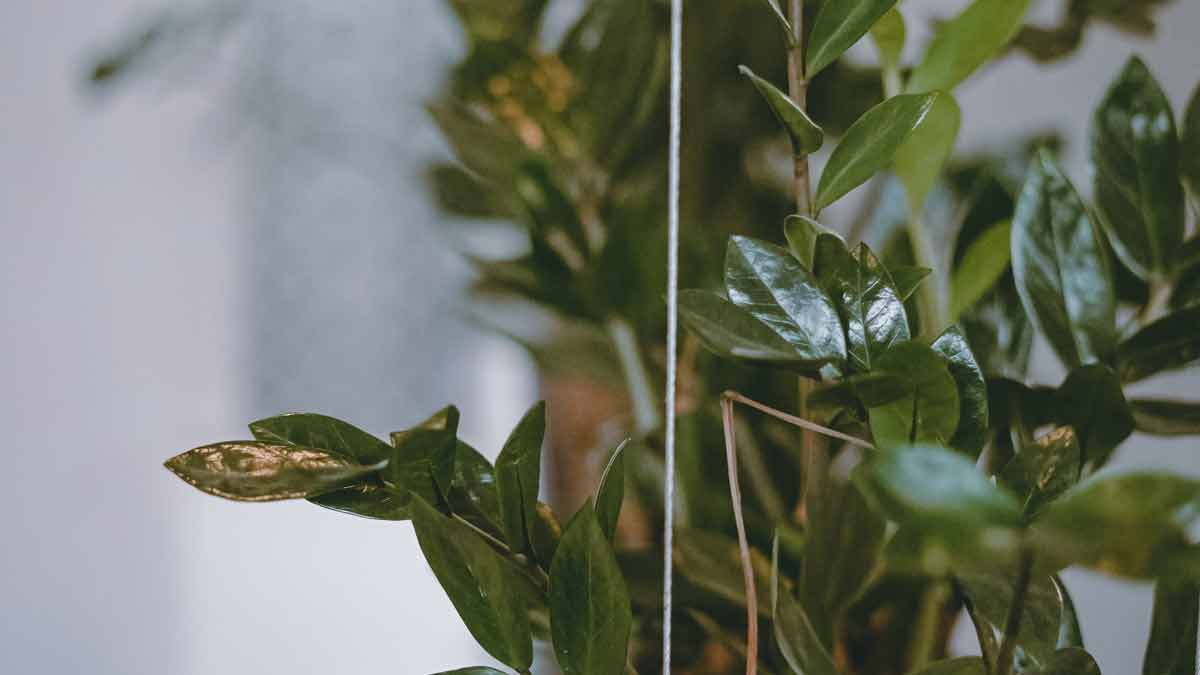Key Takeaways
- Overwatering, pests, direct sunlight, fungal infections, and nutrient deficiencies can cause white spots on ZZ plants.
- To treat white spots on ZZ plants, it is important to identify the cause and remove affected leaves. Applying a fungicide or insecticide as necessary and adjusting watering and lighting practices can also help treat the issue.
- Prevention is key in maintaining healthy ZZ plants through proper fertilizing techniques, optimal lighting conditions, regular inspections, and choosing the right environment for their growth.
Are you a proud owner of the low-maintenance ZZ plant but concerned about unsightly white spots appearing on its leaves? Worry not!
Here we’ll explore various causes behind these pesky spots and delve into effective treatments to restore your beloved houseplant’s health.
We’ve covered you, from identifying possible culprits such as pests and diseases to providing actionable tips on proper care for your Zamioculcas zamiifolia (ZZ plant).
Causes Of White Spots On ZZ Plants
White spots on ZZ plants are often caused by overwatering, pest infestations, direct sunlight, fungal infections, and nutrient deficiencies.
Overwatering
Overwatering is a common issue that many plant owners face, especially when caring for ZZ plants.
The Zamioculcas zamiifolia, also known as the Zanzibar gem or ZZ plant, is a low-maintenance and resilient houseplant thrives in various indoor environments.
The signs of overwatering include weakened grey stems, leaves with a rotten base, yellowing leaves, and, ultimately, plant death.
To prevent this problem, always use well-draining potting mixes and pots with drainage holes to avoid soggy soil.
Water your ZZ plant only when the top inch of soil has dried out completely – generally, every two to three weeks should suffice.
Adjust your watering schedule according to seasonal changes.
During colder months, reduce the frequency since the plant’s growth slows down and requires less moisture during this period.
Pest Infestation
An infestation of pests can be a common cause of white spots on the leaves of ZZ plants.
These hardy houseplants may attract insects such as aphids, mites, whiteflies, scales, mealybugs, and gnats.
Among these pests, mealybugs are particularly notorious for causing white spots on ZZ plant leaves.
These soft-bodied insects have a distinct oval shape and are covered in a waxy substance, allowing them to effectively feed on plant sap by piercing the leaf tissue.
To keep these troublemakers at bay and maintain your ZZ plant’s vibrant appearance, regular inspection and prompt action against any pest activity are crucial steps in proper houseplant care.
If you notice small colonies of pests lingering around your beloved or any signs of damage caused by insects or yellowing leaves, apply an insecticidal soap to the affected areas according to the product instructions.
This will prevent the spread of the infestation and protect other indoor plants nearby.
Direct Sunlight
Direct sunlight can contribute to the development of white spots on ZZ plants.
Known for their ability to thrive in low light conditions, these popular houseplants can become stressed and damaged when exposed to excessive heat or direct sunlight.
As a plant owner, finding an ideal spot in your home that offers bright indirect light rather than direct sunlight for your ZZ plant (Zamioculcas zamiifolia) is crucial.
Consider placing your beloved Zanzibar Gem near an east or north-facing window where it will receive sufficient yet diffused natural light.
Remember, while these hearty indoor plants are relatively low-maintenance with moderate lighting needs, extended exposure to direct sunlight can lead to unsightly white spots and compromised overall health.
Fungal Infections
Fungal infections are one of the common causes of white spots on ZZ plants.
Powdery mildew, for instance, can be a significant issue caused by a fungus that presents as white or grayish spots on the leaves.
This fungal infection can quickly spread if not treated promptly with an appropriate fungicide.
Another fungal disease that may affect ZZ plants is Rhizoctonia root rot, which manifests in brown lesions on roots and tubers.
If you notice any signs of fungal diseases on your ZZ plant, take action immediately to prevent further damage.
Nutrient Deficiencies
Nutrient deficiencies can lead to the development of white spots on ZZ plant leaves.
This occurs when the plant is not getting enough of a particular nutrient or minerals required for growth and health.
To prevent nutrient deficiencies from occurring, it’s important to use high-quality potting mixes with added nutrients and regularly fertilize ZZ plants using liquid fertilizer.
When choosing a soil mix for your ZZ plant, ensure it is well-draining and provides ample nutrition.
Regular observation and care practices that ensure adequate amounts of all necessary elements will help keep your ZZ plants healthy and free from white spots caused by nutrient deficiencies.
Diagnosing And Treating White Spots On ZZ Plants
If your ZZ plant has white spots, it’s crucial to pinpoint the root cause, get rid of any affected leaves, and use a fungicide or insecticide as needed.
Additionally, adjusting your watering and lighting methods can aid in treating the problem.
Identify The Cause
If you notice white spots on your ZZ plant, it’s essential to identify the cause before taking any action.
Pests like mealybugs, scale insects, and aphids can leave small white or yellow spots on the leaves as they feed on the plant’s sap.
Fungal infections, such as powdery mildew or bread mold, can also result in white spots that spread quickly across the leaves.
Cultural issues like overwatering or exposing your ZZ plant to direct sunlight for extended periods can also cause white spots on leaves.
Poor-quality potting soil or using a mix that doesn’t drain well could lead to waterlogged roots and black spots on the ZZ plant.
Remove Affected Leaves
You must take action promptly if you notice any white spots on your ZZ plant.
One effective way of addressing this problem is by removing the affected leaves using these steps:
- Inspect your ZZ plant for any leaves with white spots.
- Ensure you use sterilized pruning shears or scissors to avoid introducing new infections.
- Cut the affected leaves at the base, leaving a small stem section intact.
- Discard the removed leaves and sanitize your tools afterward with alcohol or bleach solution to prevent fungal diseases or pests from spreading.
Removing infected leaves from your ZZ plant can help stop the spread of disease and promote healthier growth over time.
Nevertheless, remember that prevention works better than cure; thus, properly caring for your ZZ plant should be a top priority to avoid future problems.
Apply A Fungicide Or Insecticide
A fungicide or insecticide can effectively treat white spots on ZZ plants caused by fungal infections or pest infestation.
Here are the steps to follow:
- Choose the appropriate product: Select either a fungicide or insecticide, depending on the cause of the white spots. Check labels and read reviews before buying.
- Dilute and apply: Mix the fungicide or insecticide according to the directions on the package. Drench the soil around the plant base and spray all parts of the ZZ plant affected with white spots.
- Repeat applications: The treatment process may require multiple applications, so consistently repeat it as per instruction.
- Observe results: Pay attention to changes in the plant’s health, growth and look for any further signs of pests or diseases.
Adjust Watering And Lighting Practices
To address white spots on ZZ plant leaves, it’s crucial to adjust watering and lighting practices.
Here are some steps to follow:
- Check the soil moisture level regularly – ZZ plants prefer well-draining soil that’s not too wet or dry.
- Water only when necessary – Overwatering can cause root rot and lead to white spots on the leaves.
- Place the plant in a bright location – However, direct sunlight can scorch the leaves, causing brown spots or tips.
- Provide indirect sunlight – ZZ plants thrive in bright indirect light, which promotes healthy growth and prevents sun damage.
- Avoid low light conditions – Insufficient lighting can cause stunted growth and the yellowing of the leaves.
- Keep the temperature moderate – ZZ plants prefer warm indoor temperatures between 65-75 degrees Fahrenheit.
Prevention Of White Spots On ZZ Plants
To avoid white spots on ZZ plants, it’s important to water and fertilize them correctly, ensure they have the right light and temperature, keep an eye out for pests or diseases, and ensure they are in a suitable environment.
Proper Watering And Fertilizing Practices
Proper watering and fertilizing practices prevent white spots on ZZ plants. Consider the following tips:
- Water ZZ plants only when the top two inches of soil have dried.
- Avoid overwatering or underwatering ZZ plants, as both can lead to white spots and other plant problems.
- Use a well-draining potting mix to ensure proper drainage and prevent root rot.
- Fertilize ZZ plants every other month during active growth with a liquid fertilizer diluted to half strength.
- Avoid over-fertilizing ZZ plants; excessive nutrient levels can lead to white spots and leaf burn.
Optimal Lighting And Temperature
ZZ plants are incredibly forgiving regarding lighting and temperature, making them an excellent choice for indoor growing.
These plants thrive in bright, indirect light but can also handle lower light conditions.
When it comes to temperature, ZZ plants prefer warmer environments between 60-75°F.
They can tolerate temperatures as low as 45°F but suffer if exposed to frost or freezing temperatures.
Keeping your ZZ plant away from cold drafts and extreme heat sources is essential for its health.
Choosing The Right Environment
To prevent white spots on ZZ plants, creating the right environment for your plant is important.
This means providing adequate humidity, avoiding overfertilizing, and keeping the plant in a well-draining pot with the right soil mix.
ZZ plants prefer bright indirect light, so placing them near a window with plenty of natural light is ideal.
Proper watering practices are another key factor in creating the optimal environment for your ZZ plant.
Overwatering can lead to root rot and other issues that contribute to the development of white spots on leaves.
It’s critical to allow the top inch of soil to dry out before watering again, and never let your plant sit in standing water.
Regularly Inspecting Plants
Regular inspection of your ZZ plant is crucial in maintaining its overall health.
Inspecting the leaves and stems for any sign of pests or diseases can help prevent problems before they get out of control.
When inspecting, check both sides of the leaves and the base of the stem where it meets the soil.
In addition to checking for pests and diseases, regular inspections can also provide insight into how your plant is responding to its environment.
For example, if you notice yellowing leaves or leggy growth, this could indicate that your plant needs more light or proper nutrients.
Final Thoughts
Identifying and treating white spots on ZZ plants can be done by understanding the various causes of these spots, including pests and diseases.
Proper diagnosis is crucial in determining the right treatment, such as applying fungicides or insecticides and adjusting watering practices.
Prevention is also key in maintaining healthy ZZ plants through proper fertilizing techniques, optimal lighting conditions, regular inspections, and choosing the right environment for their growth.







